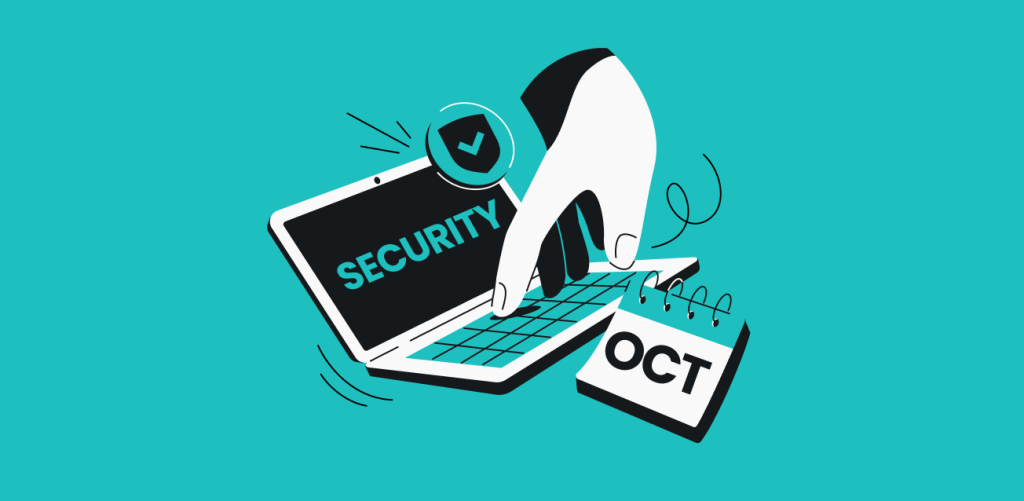
This year marks the 20th anniversary of Cybersecurity Awareness Month. It’s an annual event held every October to promote awareness and understanding of cybersecurity issues. Why is it important and why should it matter to you? Let’s dig into the details together!
Table of contents
The basis of Cybersecurity Awareness Month
Tautvydas Jasinskas, Chief Security Officer at Surfshark:
“Cybersecurity is the relentless commitment to protecting our online world — an integral part of our everyday existence — from evolving threats. Our goal should be to foster a culture of security, including everyone’s collaboration and persistent pursuit of resilience. Ultimately, cybersecurity is the mission we have to lead to ensure a safer and more secure digital future for all.”
In 2004, the US Department of Homeland Security and the National Cyber Security Alliance launched the Cybersecurity Awareness Month initiative to ensure that everyone can access the necessary resources to improve their online safety. Since then, various organizations, communities, and businesses have dedicated October to educational initiatives that help achieve this goal.
What’s the focus of this initiative? Highlighting the importance of cybersecurity, raising awareness about cyberthreats, and promoting best practices for online safety. Each year focuses on different themes. This year, the spotlight is on:
- Activating multi-factor authentication;
- Using strong passwords and a password manager;
- Updating software regularly;
- Identifying and reporting phishing attempts.
Just like spring is the time to wipe away all the dust in your house, October can become your time to get rid of online threats and ensure your online presence is spotlessly secured.
Why is it important?
Christian Dawson, Executive Director at i2Coalition:
“The number one cybersecurity threat to a system is its users.”
Unfortunately, scams, hacks, and data breaches are a big part of today’s digital reality, and recognizing them is essential for staying safe. Scams can have serious consequences — for example, social engineering scams in the US cost $8.3B in financial losses in 2022. Approximately 234K Americans fell victim to them, each losing an average of $35K.
So what’s the best way to protect yourself from online threats? You can use all available security tools to increase your online safety. Still, nothing will save you from the weakest link in cybersecurity — the human factor. That’s why educating yourself about online security, data protection, and the latest threats and vulnerabilities is essential.
Diego Naranjo, Head of Policy of European Digital Rights:
“The worst mistake someone can make when taking care of their online presence and digital safety is “not taking action.”
How can you improve your online safety?
At Surfshark, we strive to help everyone be safer and more in control of their online lives. So, to celebrate Cybersecurity Awareness Month, let’s look at some tips on securing your data and devices from potential online dangers.
Neeti Biyani, Senior Advisor for Policy and Advocacy at the Internet Society (ISOC):
“Use encryption! Choose secure ways of accessing and communicating online. Whether visiting websites or chatting with friends, there are easy ways to stay safer and more secure. Check if the connections to the websites you’re visiting are secured with the HTTPS protocol; choose an end-to-end encrypted email or messaging service; and finally, spread the word.”
But that’s not all you can do to protect your online presence. Here are more ways to stay safe:
- Always be careful about clicking any links. Make sure the sender is legitimate — for example, if the suspicious email or text is supposedly from your bank, it is better to log in through the bank’s official website instead of the link.
- Enable two-factor authentication for your accounts. Two-factor authentication is a security method that helps prevent specific attacks, such as brute-forcing. It introduces an additional step when you’re logging in, which, in turn, makes it much harder to guess your password with automated tools.
- Use strong passwords. Make them at least 12 characters long, and mix symbols, numbers, upper- and lowercase letters. Also, avoid using actual words, combinations of words, or obvious substitutions (for example, Fatal1ty instead of fatality).
- Use a VPN. If you want to ensure no one’s tracking your online activity and your IP address remains hidden, there’s no better way than a VPN (Virtual Private Network). It encrypts your connections and hides your IP address, keeping your data safe from the strangers on the internet.
- Stay aware of cybersecurity threats. Stay informed on online dangers — this way, you’ll be able to recognize them and take action immediately.
How to stay aware of online threats
Knowledge is power; in this case, it can also be your best defense against viruses, malware, and other online dangers. But with so much information out there, how can you always be aware of the latest cybersecurity trends?
You can follow Surfshark and its Research Hub! We are continually sharing our latest discoveries and cybersecurity tips. We have a weekly project called Chart of the Week, where we share insights on varied cybersecurity topics, like naming the most data-hungry language apps or looking into internet restrictions in Africa. We also regularly publish our research findings and projects, such as the Digital Quality of Life Index, Data Breach Map, and more.
The easiest way to follow us is on social media — find Surfshark on Facebook, Instagram, X (formerly Twitter), Reddit, and Discord.
